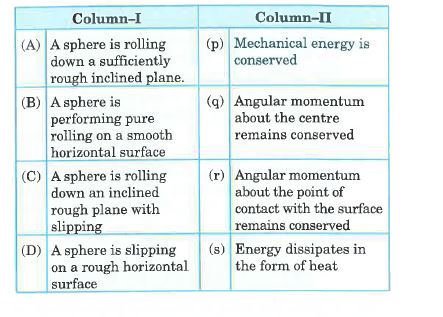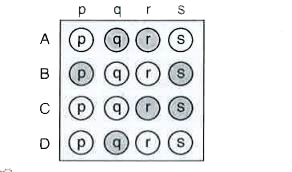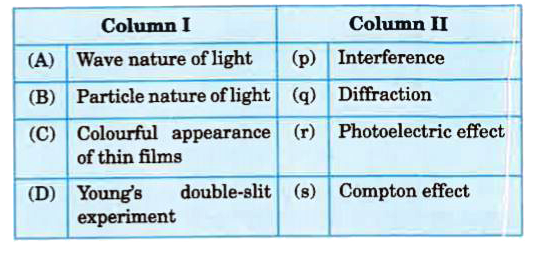Each question contains statements given in two Columns, which are to be a matched. Statements in Column-I are labelled as B A, B, C and D, whereas statements in Column-II C are labelled as p, q, r and s. Match the entries of D Column-I with appropriate entries in Column-II. Each entry in Column-I may have one or more than one correct option from Column-II. The answers to these questions have to be appropriately bubbled as illustrated in the given example, if the correct matches are A→(q,r),B→(p,s),C→(r,s) and D→(q)

The correct Answer is:A, B, C, D
A→(p,q,r,s)
Gamma rays are electromagnetic waves which have highest penetrating power and cause nuclear reactions.
B→(r)
γ rays also have penetrating power but less than gamma rays and can cause nuclear reactions.
C→(q):
When a radioactive element emits β− rays, then the mass number of the element remains unchanged and only atomic number increases.
D→(q)
For a positron emission by a radioactive element, mass number remains same and atomic number of daughter nucleus decreases.
Topper's Solved these Questions
- NUCLEIBOOK - MODERN PUBLICATIONCHAPTER - NUCLEIEXERCISE - COMPETITION FILE (INTEGER TYPE QUESTIONS)
10 Videos
- NUCLEIBOOK - MODERN PUBLICATIONCHAPTER - NUCLEIEXERCISE - COMPETITION FILE (NCERT EXEMPLAR PROBLEMS OBJECTIVE QUESTIONS)
10 Videos
- NUCLEIBOOK - MODERN PUBLICATIONCHAPTER - NUCLEIEXERCISE - COMPETITION FILE (MATCHING TYPE QUESTIONS)
1 Videos
- MOVING CHARGES AND MAGNETISMBOOK - MODERN PUBLICATIONCHAPTER - MOVING CHARGES AND MAGNETISMEXERCISE - CHAPTER PRACTICE TEST
13 Videos
- RAY OPTICS AND OPTICAL INSTRUMENTSBOOK - MODERN PUBLICATIONCHAPTER - RAY OPTICS AND OPTICAL INSTRUMENTSEXERCISE - CHAPTER PRACTICE TEST
14 Videos
Similar Questions
Each question contains statements given in two Columns, wihich are to be matched. Statements in Column-I are labelled as A, B, C and D whereas statements in Column-II are labelled as p, q, r and s. Match the entires of Column-I with appropriate entries of Column-II. Each entry in Column-I may have one or more than one correct option from Column-II. The answers to these questions have to be appropriately bubbled as illustrated in the given example. If the correct matches are A→(q,r),B→(p,s),C→(r,s)andD→(q), then correctly bubbled matrix will look like the following:

View SolutionEach question contains statements given in two columns, which have to be matched. Statements in column-I are labelled as A and D whereas statements in column-II CP are labelled as p, q, r and S. Match the entries of DP S column-I with appropriate entries of column-II. Each entry in column-I may have one or more than one correct option from column-II. The answers to these questions have to be appropriately bubbled as illustrated in the given example, if the correct matches are A→(q,r),B→(p,s),C→(r,s)andD→(q).

View Solution
Knowledge Check
Each question contains statements given in two columns, which have to be matched. Statements in Column I are labelled as A, B, C and D whereas statements in Column II are labelled as p, q, r and s. Match the entries of Column I with appropriate entries of Column II. Each entry in Column I may have one or more than one correct option from Column II. The answers to these questions have to be appropriately bubbled as illustrated in the following example. If the correct matches are A-4, A-r, B-p, B-, C-r, C-s and D-q, then the correctly bubbled matrix will look like the following:

Match the element in column I with the property mentioned in column II
 A(q) , (s)B(p), (q)C(q), ( r)D(p),(q),(s)
A(q) , (s)B(p), (q)C(q), ( r)D(p),(q),(s)
Each questions contains statements given in two columns, which have to be matched. Statements in column - I are labelled as A,B,C and D, whereas statements in column-II are labelled as p,q,r and s. Match the entries of column-I with appropriate entries of colomn-II . Each entry in column-I may have one or more than one correct option from column - II. The answers to these questions have to be appropriately bubbled as illustrated in the given example, if the correct matches are A→(q,r),B→(p,s),C→(r,s)andD→(q).

View SolutionEach question contains statements given in two columns, which have to be matched. Statements in Column I are labelled as A, B, C and D whereas statements in Column II are labelled as p, q, r and s. Match the entries of Column I with appropriate entries of Column II. Each entry in Column I may have one or more than one correct option from Column II. The answers to these questions have to be appropriately bubbled as illustrated in the following example. If the correct matches are A-4, A-r, B-p, B-, C-r, C-s and D-q, then the correctly bubbled matrix will look like the following:

Match the element in column I with the property mentioned in column II

View SolutionEntries of Column-I are to be matched with entrices of Column-II. Each entry of Column-I may have the matching with one or more than entries of Column-II

View SolutionEntries of Column-I are to be matched with entrices of Column-II. Each entry of Column-I may have the matching with one or more than entries of Column-II

View SolutionEntries of Column-I are to be matched with entrices of Column-II. Each entry of Column-I may have the matching with one or more than entries of Column-II

View SolutionEntries of Column-I are to be matched with entrices of Column-II. Each entry of Column-I may have the matching with one or more than entries of Column-II

View SolutionEntries of Column-I are to be matched with entrices of Column-II. Each entry of Column-I may have the matching with one or more than entries of Column-II

View Solution
